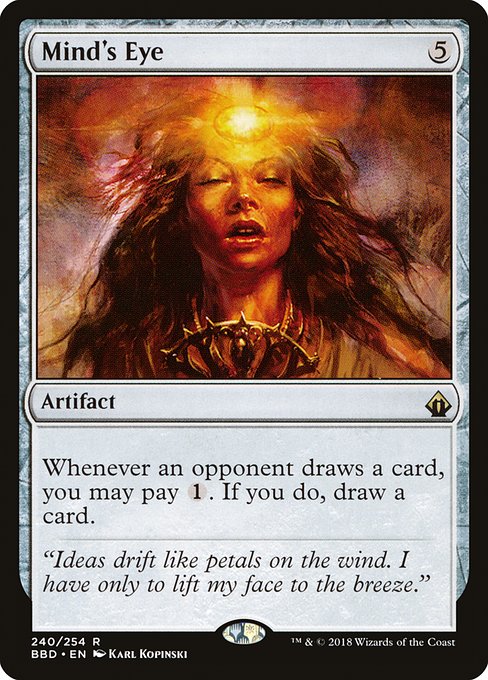
Image courtesy of Scryfall.com
Mind's Eye and Graveyard Recursion: MTG Draw Loop
When you first slot Mind's Eye into a deck and peer across the table at a crowded board, you might not realize how quietly explosive this Battlebond-era artifact can become in the right hands. For five mana, you gain a steadfast draw engine that thrives on the shots your opponents take. The card reads, “Whenever an opponent draws a card, you may pay {1}. If you do, draw a card.” That little nudge—one mana each time someone on the other side scoops a card—can snowball into a true draw loop when paired with graveyard recursion. And in a format where social maneuvering matters as much as board presence, Mind's Eye rewards you for turning other players’ card flow into your own advantage. The flavor text—“Ideas drift like petals on the wind. I have only to lift my face to the breeze.”—feels like a wink to the kind of patient planning that makes this card sing. 🧙♂️🔥💎⚔️
“Ideas drift like petals on the wind. I have only to lift my face to the breeze.”
How the Eye stays alive: the graveyard as a resource
Graveyard recursion is the quiet backbone of this approach. Mind's Eye itself is an artifact designed to draw attention, but it becomes even more potent when you can bring it back into the battlefield after it’s been shuffled away by removal or discarded into the graveyard. The game plan is simple in theory: you enable a steady trickle of cards into the graveyard, then repeatedly return useful artifacts to the battlefield so that Mind's Eye remains a continuous engine. In a multiplayer setting, this also gives you a built-in way to weather broad disruption, because your opponents’ draws—once they happen—become a ledger you can profit from, provided you can keep the Eye in circulation. 🧙♂️🎲
Key to this strategy is building a small, reliable toolbox of graveyard-recursion options. The goal isn’t to assemble the flashiest one-turn combo, but to sustain a multi-turn engine that keeps Mind's Eye humming while you advance your broader plan. You don’t need to reinvent the wheel with every game; a few dependable pieces in the right colors and a couple of resilient ways to bring artifacts back from the graveyard can do the trick. The endgame isn’t a single blow; it’s a drawn-out, resourceful grind that ends with you netting card after card and your foes staring at a widening gap in hand size. 🧙♂️💎
Practical toolbox: what to look for in a Mind's Eye + graveyard-recursion suite
- Eternal Witness — a green staple that can retrieve an important card from your graveyard to your hand, enabling you to re-fuel the Eye after a setback. This is the classic way to keep your options open and your Mind's Eye ready to flip more wheels into your favor.
- Regrowth-style effects — simple, reliable graveyard-to-hand returns that keep your curve smooth and your recursion sustainable. They’re the bread-and-butter of any Eye-centric deck looking to weather disruption and stay operational across turns.
- Artifact recursion and recycling tools — tools that help you fetch or replay artifacts from the graveyard or exile, preserving your Eye and other critical pieces. These create a dependable engine rather than a fragile burst sequence, which matters when opponents start throwing disruption spells your way.
- Wheel effects or forced-draw prompts — since Mind's Eye rewards you when opponents draw, effects that push multiple players to draw can unleash the Eye’s value multiple times in a single turn. In multiplayer formats, these can be the difference between a slow grind and a table-flipping finish.
In actual play, you might set up turn-by-turn sequences like this: you establish Mind's Eye on the battlefield, then stage a turn where an effect causes several players to draw a wheel of draws. Each opponent draw triggers the Eye; you pay {1} to draw a card for each trigger—keeping your hand healthy and your options open. When the Eye inevitably faces removal, you reach into the graveyard with Eternal Witness or a similar effect, pull it back, and relaunch the engine. It’s a patient, resilient loop that can outlast reactive strategies and still feel like you’re crafting a story at the table rather than executing a single big combo. 🧙♂️🔥
Flavor, art, and the cultural footprint
Mind's Eye sits in Battlebond, a set designed to celebrate both the casual thrill and competitive depth of MTG. The card’s rarity—rare—and its non-colored identity emphasize its role as a specialized artifact engine rather than a generic staple. Karl Kopinski’s artwork captures a maestro of ideas, aligning perfectly with a strategy that turns other players’ thought processes into your own drawing power. The flavor text about drifting ideas helps to frame the Eye not as a brute force engine but as a catalyst that makes the whole game feel like a collaboration with fate, where your careful sequencing pays off as your opponents draw into your plans. 🎨🧠
If you’re building a heady, graveyard-forward deck around Mind's Eye, you’re joining a tradition of resourceful MTG players who treat the graveyard as a living resource and a springboard for sustainable value. It’s a design space that rewards planning, table talk, and a little bit of risk-taking—perfect for those who love sequencing, timing, and the delicious tension of a draw that might just tilt the game in your favor. ⚔️
Thinking about upgrading your desk setup to match your MTG mood? The neon desk pad in the promo link below is a perfect companion for long drafting sessions or casual nights—bright enough to keep you focused, classy enough to impress at the table. 🎨